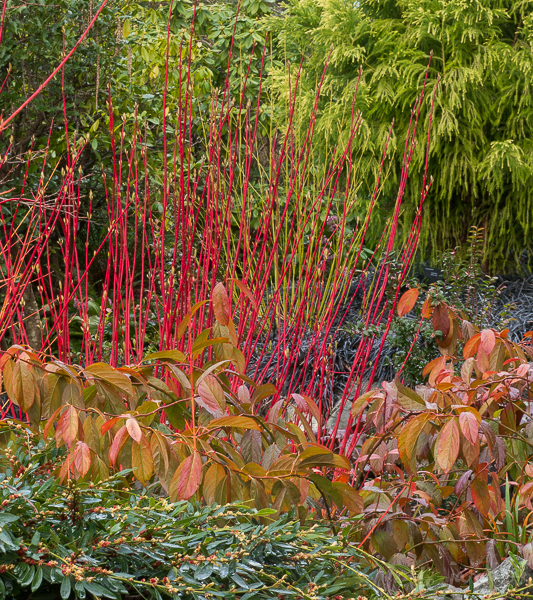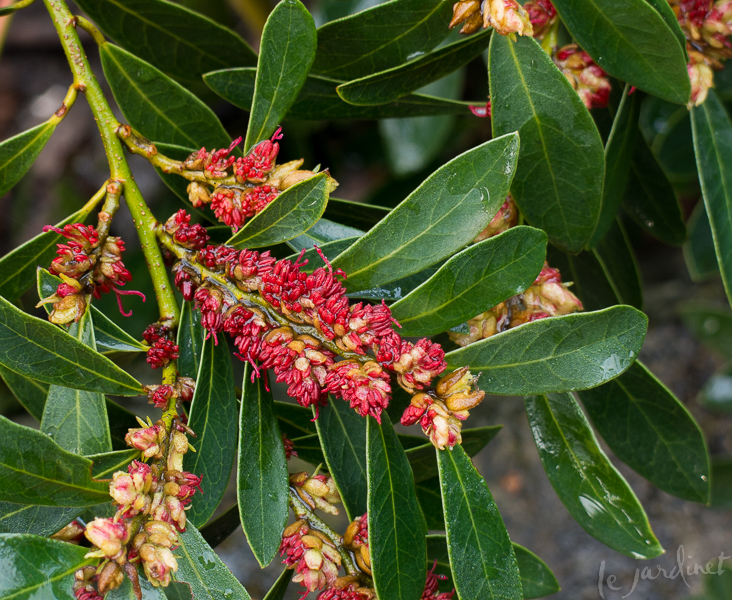Move over boxwood – make room for Distylium!

Have you been searching for the perfect shrub? One that is
- low maintenance
- evergreen
- deer resistant
- insect resistant
- disease resistant
- can be used for hedging, screening, as a foundation plant, groundcover or as part of a mixed border?
- is tolerant of wet soils, yet also
- drought tolerant?
Maybe something to replace those ailing boxwood that have succumbed to blight? Or a change from the over-used laurel?
Drum roll please and welcome ……
Distylium
This is the great little shrub you may not have heard of, especially if you live in the Pacific Northwest, although in the south it has been heralded for a few years now. The cold hardiness of the available species and hybrids of distylium varies somewhat*, so be sure to ask advice from a local horticulturalist and select the right one for your area, but all have wonderful, glossy evergreen foliage. I especially love the reddish new growth that most exhibit as well as the small, red winter flowers. Granted, from ten feet or so away the tiny flowers are barely noticeable – so get up close and personal to enjoy theses tiny treasures that are hidden in plain sight.
All do well in full sun (even Atlanta-type full sun) or partial shade and are easily clipped or sheared, or can be left to assume a more relaxed shape.
I recently had the opportunity to visit the Bailey Nurseries growing facility in Atlanta to learn more about their selection and propagation processes but also to see first hand how their First Editions distylium hybrids are being used in residential and commercial landscapes.
Designing with distylium
Create a vertical accent or privacy screen
- Linebacker has a strong vertical form
- Combine with abelia for easy care and color contrast. Seen here with Abelia 'Radiance'
Linebacker has a compact, upright form so is ideal for taller hedges or screens, perhaps as an alternative to the ubiquitous laurel or disease-plagued Photinia. I liked the color echo between the reddish new distylium growth and the stems of Abelia x grandiflora 'Radiance'
As a low hedge

Set back from the path and framed with a low growing grass, Vintage Jade makes an elegant yet informal hedge
Vintage Jade is a low, spreading variety that lends itself well to be used as an informal hedge in the ornamental garden, to line a driveway, as a foundation plant or as a weed-smothering groundcover.
As part of a mixed border

Combined with red and yellow twig dogwood, Virginia sweetspire and Sekkan-sugi cryptomeria, distylium (foreground and in bloom) creates a stunning winter combination
The Doris Page Winter Garden at the Horticulture Center of the Pacific in Victoria B.C shows how this underutilized shrub can be used to great effect in a mixed border. My co-author (Christina Salwitz) and I featured this combination in our book Gardening with Foliage First. The distylium shown in the photo above is the species D. myricoides, which overall is less cold hardy than the First Editions hybrids although it shares the same attractive layered habit. Notice how the rich green distylium foliage frames the fiery tones of the stems and foliage beyond it, and how its tiny red flowers echoes the color of the dogwood stems.
*Hardiness and Recommendations for Zone 6b
I have been growing Cinnamon Girl in my Duvall, WA test garden for about three years now. We are a little colder than downtown Duvall and certainly much colder than Seattle. We have a high water table and clay soil. This site receives full sun from sunrise until ~ 2pm in peak summer. The house may give it some frost protection.
Cinnamon Girl has a smaller leaf than the other varieties mentioned above and has been shown to be the most cold hardy to date. (Coincidentally, the smaller leaved varieties of hebe are also the most cold hardy).
This suffered some winter burn the first year which it quickly outgrew, but now it has become established it seems much more robust and survived several weeks under snow last year. It still remains under 3 feet tall but has spread to just over 4 feet wide. I love the layered habit so if you want to enjoy this feature also, be sure to space the shrubs to allow for that. I have not seen deer damage (although they have nibbled adjacent plants) and this has never been watered after the first summer it was installed. In fact even as I'm writing this I can think of several other areas of my garden where this would be an excellent candidate….!
Expert Michael Dirr, suggests that Vintage Jade is also hardy to zone 6b, but that otherwise the First Editions hybrids should all be considered hardy in zones 7-9, while the species D. myricoides is more tender (7b)
Share your ideas!
How have you used this shrub? Let me know your experiences and ideas by commenting below!
Subscribe to Receive Blog Posts
Gardening inspiration delivered right to your inbox from Le Jardinet



unfortunately too tender for our zone 4-5 here on the coast of Maine…but isn't it lovely!!
I know – sorry!
I love these plants! Bailey sent me some a few years ago and they are truly amazing.
Yes they are! Which variety does best for you in Austin?
Need a few of those to replace the sluggish-growing boxwood that I planted on a mound 3 years as boundary marker between two properties. The boxwood plants turn brown/orangy in the winter looking dead instead of interesting and they resent going dry in the summer! Ths plant would be much nicer and cute blossoms too? How difficult is it for the growers to propagate it? Why have we not seen in it being sold in the Pacific NW? Thanks! I enjoyed reading and the photos too 🙂 🙂
Hey Cecilia, I don't have information on difficulty of propagation but you can see who carries the First Editions shrubs by using the 'Search for a Retailer' box on this page http://www.firsteditionsplants.com/. Then call and request them!
I should have edited my sloppy comment above. Sorry 🙂
Here is a better version of it: "Need a few of these to replace the sluggish-growing boxwood that I planted on a mound three years ago as a boundary marker between two properties. Now there are other low-growing evergreen shrubs on the 150 feet long mound. In 2018 we planted in between the other low-growing groundcovers about 38 'Blue Point' junipers with the intent to grow a hedge. About 10 percent of the junipers turned brown and died. Unsure if it was the planting spot, or the plant had a disease in the root system. The retailer did not guarantee the trees! I have planted literally hundreds of evergreen shrubs and trees in the past 30 years and they have become healthy and robust hedges. I had not planted 'Blue Point' before. Last year, we also planted in another location (with nasty bluish clay and rocks) ten 'Sky Rocket' junipers and they have thrived and look undaunted about the terrible soil. We have amended, mulched, fertilized, etc., etc., all of the planting holes. It does sound like the Distylium would not be as fickle as a 'Blue Point' and fairly tolerant to occasional drought and/or a wet winter. We water with a hose during the drier and warmer season in Sequim, WA.
The boxwood plants turn brown/orangey in the winter looking dead instead of interesting and they resent going dry in the summer!
The Distylium would be much nicer and would have the cute blossoms!
Do you know how difficult it is for the growers to propagate it?
Wondering why we have not seen Distylium being sold in the Greater Puget Sound area where we have the milder winters?
I enjoyed reading the article and your photos as well 🙂 🙂Thanks Karen!